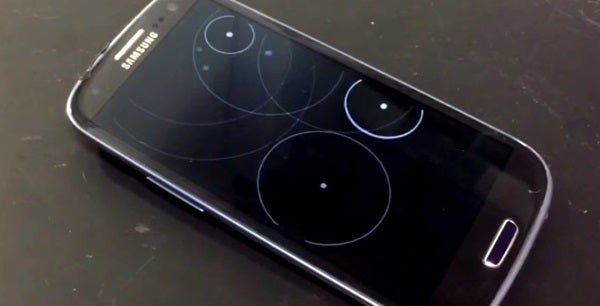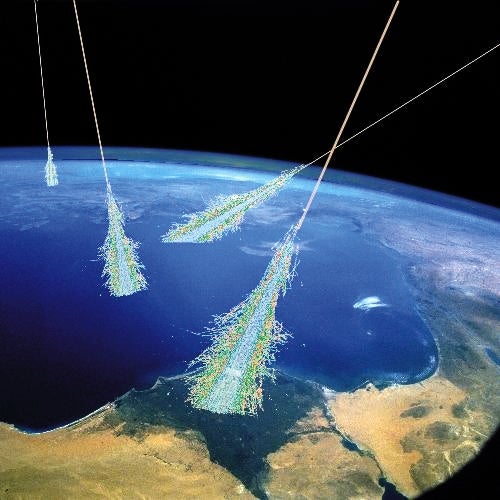Well, researchers from the Laboratory of Methods for Big Data Analysis (LAMBDA) have a suggestion: Use your smartphone to help them track ultra-high energy cosmic rays.
By downloading the CRAYFIS app, which operates on an idle smartphone much like a screensaver, you can join a world-wide network of handheld cosmic ray detectors. In addition to helping unravel the mysterious origins of high-energy cosmic rays, anyone whose phone collects enough data will also be listed as an author on at least one scientific paper.
What are cosmic rays?
Cosmic rays are like tiny space bullets made of charged particles. And they can come in many different forms, ranging from single protons to heavy atomic nuclei, such as iron. Cosmic rays are not only charged, but also extremely energetic, traveling through space at nearly the speed of light. Astronomers are interested in these high-energy particles because, by understanding their properties, they can infer important information about the events that generated them and the structures they traveled through.
Fortunately, countless cosmic rays are constantly bombarding Earth. But unfortunately, researchers have so-far failed to determine where the most powerful of these elusive particles come from. Though it’s known that events within our galaxy can produce low-energy cosmic rays, the highest-energy versions are believed to originate from outside of the Milky Way.
It may seem like tracing the source of high-energy cosmic rays should be relatively straight forward, but the problem is that ground-based “cosmic ray” detectors do not actually detect cosmic rays. That’s because cosmic rays never actually reach the ground intact.
How does CRAYFIS work?
The CRAYFIS project focuses on tracking one specific type of secondary particle produced by cosmic-ray air showers: muons. As it turns out, smartphone cameras use technology that is very similar to that found in particle detectors. With just a simple app, a smartphone camera can effectively be tuned to detect muons produced in air showers. With enough smartphone detectors spread over a wide enough area, the researchers believe they can retrace the paths of air showers, which would help them calculate where in the sky the initial cosmic rays came from.
After a volunteer installs the CRAYFIS app on their smartphone, they leave the phone facing down overnight so that photons do not trigger the camera sensor. The app then captures megapixel images and scans through them at up to 15 frames per second. If the app’s algorithm detects any potential muon events, it sends the data back to the CRAYFIS server. Although it sounds like this would lead to a lot of detections, the researchers say that less than 1 in 500 image frames would capture a muon track.
But herein lies the problem: Even if the researchers can rally the millions of idle phones they need for the study, they are still faced with the task of separating true detections from background noise. Unsurprisingly, they already have found a solution.
“A trigger algorithm is required to eliminate background data,” said Andrei Ustyuzhanin, head of LAMBDA, in a press release. “We created a neural network for the detection of muon signals, which can be used on any mobile phone fast enough to process a video stream. A special feature makes it possible to use the algorithm on something as simple as a mobile phone, meaning that they can now analyze responses to cosmic rays.”
The neural network relies on a technique the researchers call lazy convolution. First, the trigger algorithm analyzes a high-resolution image to identify any potential areas of interest. If it doesn’t find anything noteworthy, it throws out the image (hence the lazy). However, if the algorithm finds a potential muon track, it flags the region for follow-up, discarding the rest of the image and repeating the process over again.
As the algorithm strips away more and more noise with each iteration, it refines the initial path of the triggering muon. With enough phones synched together in a massive array, the researchers think they can trace the paths of specific air showers – and, therefore, their progenitor cosmic rays.
If successful, the CRAYFIS project will enable astrophysicists around the world to sift through massive amounts of data to help pin down the mysterious origins of ultra-high energy cosmic rays. Furthermore, the authors note in the study that “the proposed method [for detecting muons with mobile phones] does not contain any application-specific assumptions and can be, in principle, applied to a wide range of problems.”
So, if you have ever wanted to participate in real astronomical research with the possibility of becoming a published author, CRAYFIS is for you. If not, I still recommend you stay tuned to the CRAYFIS project, because with the help of millions of citizen scientists, it may reveal the mysterious origins of cosmic rays.
To join the hunt for cosmic rays, simply download a beta version of the app at https://crayfis.io/.











